Research Article - (2020) Volume 10, Issue 1
Background: Unwanted pregnancy is one of the major maternal problems in developing countries including Ethiopia, which is mainly caused by contraceptive failure, early marriage, premarital sex, rape and poor knowledge of family planning method. Nowadays, from all births occurring in developing countries 20-40% is unwanted. In Ethiopia, more than half of pregnancy encountered by adolescents is unwanted pregnancy.
Objective: The aim of this study is to assess female students’ knowledge and experience of unwanted pregnancy among preparatory school, and technical and vocational education training students in southeast Ethiopia.
Methods: A school based cross sectional study was conducted using self-administered questionnaires. The study was conducted among regular female students in technical and vocational education training college and preparatory school in Ginnir town. We used random sampling method to select the study participants. We used pretested and structure questionnaire. Descriptive statistics were done for each variable. Data was analyzed using SPSS version 20 software.
Result: A total of 177 female students were participated in the study. Out of the total participants about 79% of them mentioned that they have knowledge about unwanted pregnancy. Around twenty percent of respondents have experienced pregnancy and all the pregnancies were unwanted. Socio-economic status (28.23%), failure of contraceptive (33.9%), rape (36.16%), premarital sex (45.2%) and lack of awareness (44.63%) were cause of unwanted pregnancy.
Conclusion and recommendation: In this study the prevalence of unwanted pregnancy is high. Unwanted pregnancy is a sensitive issue and one fifths of the female students still have no awareness about it; especially those who came from rural areas. Therefore; technical and vocational education training college, Ginnir high school administration and other concerned bodies have better to give special attention on the impact of this current problem.
Knowledge; Experience of unwanted pregnancy; Female students; Technical and vocational education training; Preparatory school
Unwanted pregnancy is one of the world wide problems that affect women, their families and societies. Between 20-40% of all births occurring in developing countries are unwanted posing hardship for families and jeopardizing health of millions of women and children, following these pregnancies an estimated 50 million abortions are performed in unsafe circumstances. Unwanted pregnancy is pregnancy that is not desired by one or both biologic parents. It is part of unintended pregnancy and about 45 million unwanted pregnancies are present in the world [1].
There are many contributing factors for unwanted pregnancy among those factors the common ones are limited knowledge of RH information, early marriage, limited use of contraceptives, limited knowledge of sexual physiology, contraceptive failure premarital sex and cultural factors like peer pressures [2]. Unplanned pregnancy is also common among abused women. Research has found that some abusers force their partners to have sex without birth control and/ or sabotage the birth control their partners are using leading to unplanned pregnancy. About 1 in 2 men who abuse their wives also abuse their children. And children who grow up with violence in the home are more likely to become abusers as adults and have physical and emotional problems [3].
Several studies found that those who experienced unwanted pregnancy were often poorly informed about sex and contraception. Sex education however didn’t always lead to an increase in the knowledge and use of contraception. Women who were in conflict about their work and mothering roles and women who did not want to work but felt pressure to do so frequently had inappropriate pregnancy. Teenagers who were not interested in school or in future careers often had unwanted pregnancy. These pregnancies probably represent an attempt to establish a social identity [4]. Limited knowledge of sexual physiology, early marriages, limited use of contraceptives, limited access to reproductive health information and girly limited agency over their sex lives all contribute to the high rate of unwanted pregnancy. In sub-Saharan Africa approximately 14 million unintended pregnancies occur every year and sizeable proportion is due to poor use of short term hormonal methods. Unwanted pregnancy is one of the major reproductive health challenges faced by adolescents Ethiopia. 54% of pregnancies to girls under 15 are unwanted compared to 37% for those ages 20-24 [5-11].
The prevention of unwanted pregnancy has been practiced since the beginning of recorded history. Nowadays Ethiopia, Unite States of America and United Kingdom use contraceptive, adolescent centered health education etc. to reduce prevalence of unwanted pregnancy [12]. Therefore, by identifying problems related to unwanted pregnancy, this study will evaluate the knowledge and practice of unwanted pregnancy among preparatory school, and technical and vocational education training students in the study area.
Study design, area and period
School based descriptive cross-sectional study was conducted from March to June, 2017 at Ginnir town among female students in preparatory school and technical and vocational education training college. Ginnir preparatory school was established in 2001. Total number of students enrolled in this school are 396; with total number of female=162 and male=234. Lalistu Oromia technical and vocational education training college was opened in 2007 and both regular and evening students are learning at this college. The total number of students currently enrolled in the college are 397 including regular and evening students. The total number of females is 153 and males 244. The college also comprises 39 teachers and 16 other administrative and staff workers.
Sample size determination
A sample size was calculated using single population proportion formula with assuming that, P value 50% and 95% CI as well as marginal error of 5%. By adding 10% non-response rate the final sample size was calculated to be 422.
Since the source population was less than 10,000 a correction formula was calculated to adjust our sample size and it was calculated 181.
Sampling technique
The data was collected using simple random sampling technique from regular female students in technical and vocational education training college and preparatory school at Ginner town. We used lottery method to select 181 sample female students. We used the student attendance list as a sampling frame to pick the study participants using simple random sampling method. In addition, five key informants were also recruited for interview.
Data collection method
Data was collected by pretested and structured self-administered questionnaire. An English questionnaire was used as it is the main language of communication by professionals in Ethiopian schools. Data was collected by four female BSc nurses and supervised by one public health professional with BSc degree. The questionnaire was composed of closed ended as well as open ended questions containing socio-demographic information, knowledge and practice about unwanted pregnancy.
Data analysis
Data was processed and analyzed using Statistical Program for Social Science Version 20.0 software. The frequency, percentage and cross tabulation of data with different variables was determined.
Data quality management
To ensure the completeness, accuracy and consistency of data collection, a discussion session was held each day of the data collection period. Thorough checking was done before receiving the filled questionnaires from each data collector. Data collectors and supervisors were trained for two days about the questioner and how to administer it. The questionnaire was pre-tested in Robe preparatory and technical and vocational education training school on 5% of the students before data collection to check consistency; correction was taken by identifying potential problem areas and logistic plan for data collection was done.
Socio-demographic characteristics
Among 181 total study subjects 177 students completed the questionnaire which made the response rate of 97.8%. The majority 165(93%) of the participants were found between the age range of 16-20 years. Regarding religion, one thirds 60 (34%) of the respondents were Muslim followers. The majority of 166 (94%) the students were single. In terms of educational status 67(38%), 56(32%) and 54(30%) were grade 11, grade 12 and TVET College respectively. Three fourths 132(75%) of the students were came from urban (Table 1).
| Socio-demographic variables | Frequency | Percentage | |
|---|---|---|---|
| Age | 16-20 | 165 | 93% |
| 21-25 | 12 | 7% | |
| Religion | Muslim | 60 | 34% |
| Orthodox | 104 | 59% | |
| Protestant | 13 | 7% | |
| Ethnicity | Oromo | 115 | 65% |
| Amara | 40 | 23% | |
| Gurage | 9 | 5% | |
| Others | 13 | 7% | |
| Marital status | Married | 11 | 6% |
| Single | 166 | 94% | |
| Educational status | TVET | 54 | 30% |
| Grade 11 | 67 | 38% | |
| Grade 12 | 56 | 32% | |
| Family income | Low | 43 | 24% |
| Medium | 116 | 65% | |
| High | 18 | 11% | |
| Previous residence | Urban | 132 | 75% |
| Rural | 45 | 25% | |
| Family educational status | Literate | 144 | 81.36% |
| Illiterate | 33 | 18.64% | |
| Educational level of Family (literate) | 1-8 | 59 | 41% |
| 9-12 | 53 | 37% | |
| College and University | 32 | 22% | |
Note: TVET: Technical and vocational education training.
Table 1: Socio-demographic characteristics of the study participants, southeast Ethiopia, 2017.
Knowledge towards the cause of unwanted pregnancy
About 79% of students said that they have heard about unwanted pregnancy and 21% of the respondents mentioned that they haven’t heard about it. Those who heard about unwanted pregnancy mentioned source of their information and 31% mentioned mass media, 40% mentioned school and about 29% said friends. When asked about the primary cause of unwanted pregnancy 28.23% mentioned low socio-economic status, 33.9% mentioned failure of contraceptive, 36.16% mentioned rape, 45.2% mentioned premarital sex and 44.63% mentioned lack of awareness (Figure 1).
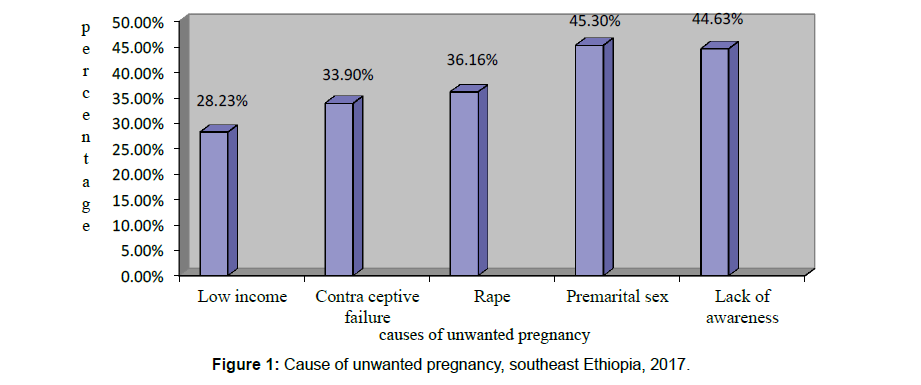
Figure 1: Cause of unwanted pregnancy, southeast Ethiopia, 2017.
Female students were also asked whether or not substance abuse like alcohol and chat can lead to unwanted pregnancy. About 65% of respondents said that unwanted pregnancy can result from substance (alcohol, chat) and the left 35% said no. They were also asked that poor marital relationship leads to unwanted pregnancy; 64% said yes and the other 36% said no (Figure 2).
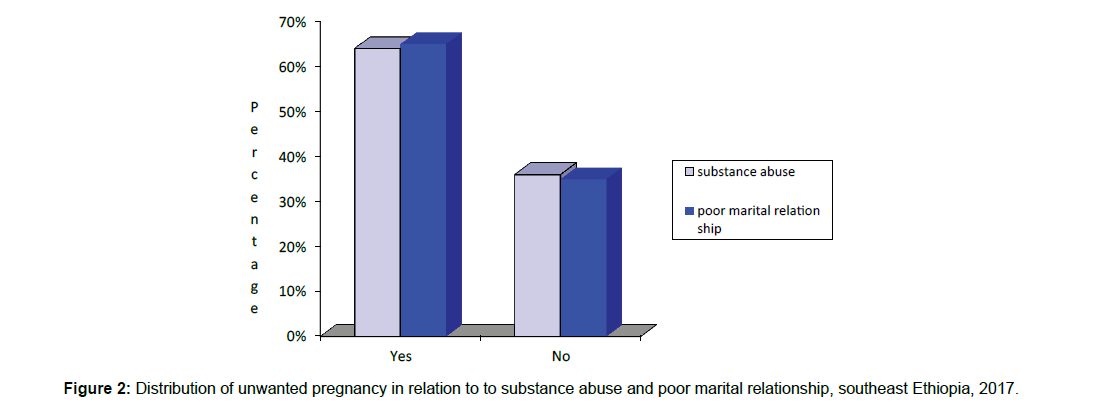
Figure 2: Distribution of unwanted pregnancy in relation to to substance abuse and poor marital relationship, southeast Ethiopia, 2017.
Among 177 respondents on consequence of unwanted pregnancy 25% said delay in education, 35% said leads o unsafe abortion, other 25% said discrimination and stigma from society and 155 said psychological crisis (Figure 3). When asked about impact on child born from unwanted pregnancy 43% mentioned that the child will not know his root and leads to personal crisis, 35% mentioned that the child will no obtain appropriate attention by his/her parents and 20% mentioned the child will face discrimination (Figure 4).
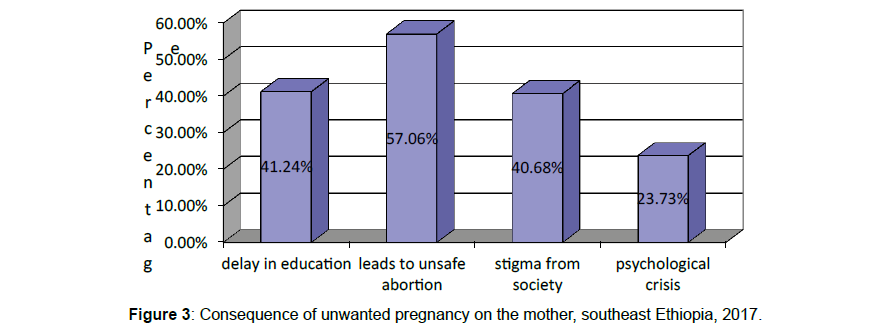
Figure 3: Consequence of unwanted pregnancy on the mother, southeast Ethiopia, 2017.
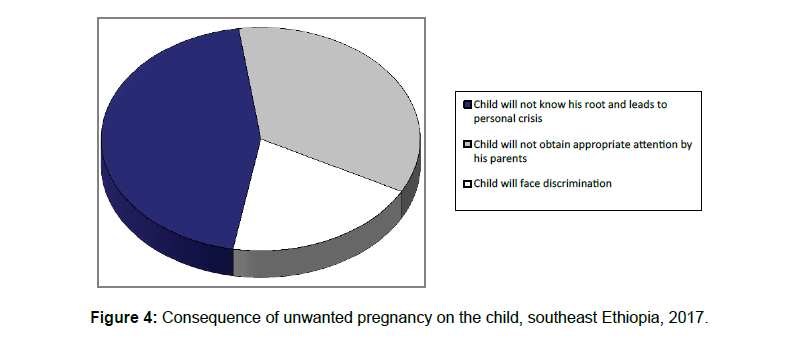
Figure 4: Consequence of unwanted pregnancy on the child, southeast Ethiopia, 2017.
Experience of unwanted pregnancy and prevention methods
About 28% of respondents mentioned that they have practiced sexual intercourse, out of this 13% are single and the other 15% are married. About 18.9% of respondents mentioned that they have practiced pregnancy in the past time. The other 81.1% reported that they didn’t practice pregnancy. When asked about the method they use to avoid unwanted pregnancy 53% mentioned abstinence, 15% mentioned hormonal contraception and 32% mentioned that they use nothing (Figure 5).
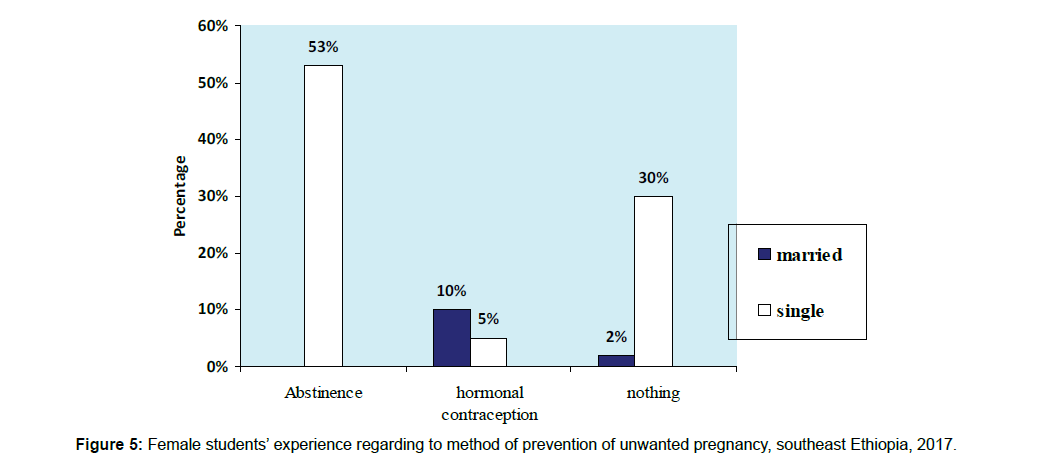
Figure 5: Female students’ experience regarding to method of prevention of unwanted pregnancy, southeast Ethiopia, 2017.
Females’ knowledge and practice of unwanted pregnancy is crucial in the implementation for creating awareness to reproductive health and reduce the risk of unwanted pregnancy. In our study about one fifths of the respondents reported that they have no awareness about unwanted pregnancy and majority of them were came from rural area. Failure of contraceptive use and low socioeconomic status were primary cause of unwanted pregnancy. This finding is less than a study reported in Nigeria [13,14]. In Russia one fourths of participants mentioned low income [10], this study finding is consistent with our study result. However, our study finding was different from study finding in Nigeria [14], India [11] and Russia [10] that was not included rape in their report.
“...Most of the students have not sufficient information about reproductive health and consequences of unwanted pregnancies since most of them are come from rural area. And the schools have not provided enough education to the students through different programs including mini media.” [Preparatory school director, age 36; technical and vocational education training college teacher, age 25].
“...One of the respondents said that regarding information and education about reproductive health and unwanted pregnancies the school and other concerned bodies have not done well. College and high school students are victims for premarital sex, unwanted pregnancy and related health and psychological vectors. ” [Preparatory school teacher, age 23]
“...Most of our students have come from rural and low socioeconomic background. So that, they will be exposed easily and enslaved for unwanted pregnancy. Most of them have started to build relationship in school since they have lived away from their family and they have opportunity to do as they want.” [Technical and vocational education training college manager, age 47].
In this study majority of the participant said that unwanted pregnancy is common in unmarried students. In study done in Moscow Russia during 1984-1985 mothers knew that unwanted pregnancy is common in unmarried than married [10,12]. Also the higher per cent of our respondents mentioned that substance abuse like alcohol and khat can result in unwanted pregnancy. This finding is agreed with a study done in Russia [10]. In our study 57.06% of the total respondents mentioned that unwanted pregnancy leads to unsafe abortion. A study done in India showed that the women knew that if they conceive they try to eliminate the pregnancy by abortion because they are unmarried at the time of pregnancy (18%), too young or still in school [11]. Unwanted pregnancy has psychological risk for mother and child born from unwanted pregnant women [6,7]. In this study on the consequence of child born from unwanted pregnancy 61.58% of the respondents mentioned the child will not know his root and leads to personal crisis, 48% mentioned the child will not obtain appropriate attention by his or her parents and 27.12% of the total respondents mentioned the child will face discrimination. A finding in Russia women said that unwanted pregnancy has psychological risk for the child development, but no difference in neonatal sequel. About 28.23% of the women believe that the child born from unwanted pregnancy has psychological risk for the child development, but no difference in neonatal sequel. They believe that the child born from unwanted pregnancy was premature; others believe that the children born low birth weight [8-11].
“...One of the respondents said that most female students have boyfriend in school. This relationship has resulted in unplanned sexual intercourse, unwanted pregnancies and abortion. In addition, these students have forced to discontent their education due to discrimination and other psychological problems.” [Technical and vocational education training college teacher, age 30].
“...Most of unmarried students have committed abortion during unwanted pregnancy since they are student and haven’t been received any support from family as well as from the community. It is sham to discuss about sexual intercourse, pregnancy and prevention methods even with their boyfriends.” [Preparatory school teacher, age 22; Technical and vocational education training college, age 42].
In this study one fourths of the study participants have a boyfriend. And only 3% of them mentioned that they have discussion about unwanted pregnancy with their friend. None of our respondents mentioned forced sexual intercourse. In our study 18.9% of our respondents mentioned that they have become pregnant in the past time and the pregnancies are unwanted. However, this finding is consistent with study finding in different areas. In Ethiopia according to DHS-2005 16.2% and 18.7 % of the study subjects reported that their last pregnancy is mistimed and unwanted respectively [11]. In study done in Kersa, eastern Ethiopia, 2010 practice of unwanted pregnancy reported by 27.9% of the study subjects [13]. A study finding in Nigeria also confirms that a large proportion of Nigerian [14] women are becoming pregnant when they do not want to.
In this study the prevalence of unwanted pregnancy was high compare to different studies conducted in Ethiopia. Unwanted pregnancy is politically, culturally, spiritually and morally a sensitive issue and many female students still have no awareness about unwanted pregnancy; especially those who came from rural areas. Majority of the students have good knowledge towards unwanted pregnancy. However, only few students have discussion of unwanted pregnancy with their boyfriend. Many students are using nothing for the prevention of unwanted pregnancy. Thus, in order to prevent the cause of unwanted pregnancy and its impact measures such as educating to create awareness among students regarding unwanted pregnancy, give client cantered reproductive health service, mobilizing NGOs in giving community and family support increasing access and acceptability of reproductive health service including family planning are important.
Ethical clearance was obtained from the Research and Publications Office of the College of Medicine and Health Sciences, Madda Walabu University. Permission was also requested to Ginnir technical and vocational education training, and preparatory school. To maintain confidentiality and accountability the individual name was not written in the data collection tool. The aim of the research and its benefit to the community was clearly explained. Informed written consent was asked after telling that they have a full right to leave the interview at any time they want.
Based on our finding we recommend that: The Ginnir town health bureau administration in collaboration with Ginnir preparatory school and TVET College has better to create awareness for the students regarding to unwanted pregnancy. The TVET College and preparatory school administration have to establish gender club in their school. The Madda Walabu University has better to conduct further study on this issue.
The authors declare that they have no any competing interests.
All authors have equal contribution to the manuscript.
Ahmed Yasin Mohammed is an assistant professor at Madda Walabu University, Abate Lette Wodera is a lecturer at Madda Walabu University and Musa Kumbi Ketaro is Lecturer and academic and research directorate at Madda Walabu University College of Medicine and Health Sciences.
We are grateful to Madda Walabu University for supporting this study. We are also very grateful to data collectors and study participants to undertake this study.
Citation: Mohammed AY, Wodera AL, Ketaro MK. (2019) Knowledge and Experience of Unwanted Pregnancy among Preparatory School, Technical and Vocational Education Training Students in Ginnir Town, Oromia Region, Southeast Ethiopia. Prim Health Care 9: 333.
Received: 31-Aug-2019 Published: 30-Dec-2019, DOI: 10.35248/2167-1079.20.10.336
Copyright: © 2019 Mohammed AY, et al. This is an open access article distributed under the terms of the Creative Commons Attribution License, which permits unrestricted use, distribution, and reproduction in any medium, provided the original work is properly cited.